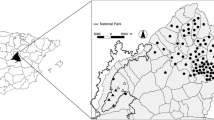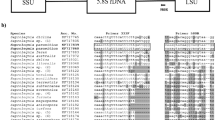Abstract
Human activities often generate or increase concentration of chemical compounds including pesticides, hydrocarbons and metals that can potentially affect ecological interactions. We found that elevated levels of zinc in pigeon feathers were associated with both low prevalence of Chlamydiaceae (ornithosis disease) and low intensity of blood pathogens (Haemosporidian parasites). In contrast, high levels of lead in pigeon feathers were associated with high blood pathogens intensities. Our results suggest that metals linked to human activities in cities such as zinc and lead may play a significant role in the ecology of host–parasite interactions and could potentially affect the epidemiology of diseases in the urban environment.


Similar content being viewed by others
References
Azimi S, Ludwig A, Thévenot DR, Colin JL (2003) Trace metal determination in total atmospheric deposition in rural and urban areas. Sci Total Environ 308:247–256
Babich H, Stotzky G (1978) Toxicity of zinc to fungi, bacteria, and coliphages: influence of chloride ions. Appl Environ Microbiol 36:906–914
Brait CHH, Antoniosi Filho NR (2011) Use of feathers of feral pigeons (Columba livia) as a technique for metal quantification and environmental monitoring. Environ Monit Assess 179:457–467
Descotes J (1992) Immunotoxicology of cadmium. IARC Sci Publ 118:385–390
Frantz A, Pottier MA, Karimi B, Corbel H, Gasparini J, Castrec-Rouelle M (2012) Contrasting levels of heavy metals in the feathers of urban pigeons from close habitats suggest limited movements at a restricted scale. Environ Pollut 168:23–28
Gasparini J, Erin N, Bertin C, Jacquin L, Vorimore F, Frantz A, Lemouvel P, Laroucau K (2011) Impact of urban environment and host phenotype on the epidemiology of Chlamydiaceae in feral pigeons (Columba livia). Environ Microbiol 13:3186–3193
Jacquin L, Lenouvel P, Haussy C, Ducatez S, Gasparini J (2011) The dark pattern coloration is related to parasite intensity and cellular immune response in an urban free living bird: the feral pigeon. J Avian Biol 42:11–15
Johnston RF, Janiga M (1995) Feral pigeons. Oxford University Press, Oxford
Lafferty KD (1997) Environmental parasitology: what can parasites tell us about human impacts on the environment? Parasitol Today 13:251–255
Percival SS (1998) Copper and immunity. Am J Clin Nutr 67(suppl):1064S–1068S
Prasad AS (1998) Zinc and immunity. Mol Cell Biochem 188:63–69
Sagerup K, Savinov V, Savinova T, Kuklin V, Muir DC, Gabrielsen GW (2009) Persistent organic pollutants, heavy metals and parasites in the glaucous gull (Larus hyperboreus) on Spitsbergen. Environ Pollut 157:2282–2290
Scheuhammer AM (1987) The chronic toxicity of aluminium, cadmium, mercury and lead in birds: a review. Environ Pollut 46:263–295
Singh VK, Mishra KP, Rani R, Yadav VS, Awasthi SK, Garg SK (2003) Immunomodulation by lead. Immunol Res 28:151–165
Snoeijs T, Dauwe T, Pinxten R, Vandesande F, Eens M (2004) Heavy metal exposure affects the humoral immune response in a free-living small songbird, the great tit (Parus major). Arch Environm Contam Toxicol 46:399–404
Snoeijs T, Dauwe T, Pinxten R, Darras VM, Arckens L, Eens M (2005) The combined effect of lead exposure and high or low dietary calcium on health and immunocompetence in the zebra finch (Taeniopygia guttata). Environ Pollut 134:123–132
Wayland M, Gilchrist HG, Marchant T, Keating J, Smits JE (2002) Immune function, stress response, and body condition in arctic-breeding common eiders in relation to cadmium, mercury, and selenium concentrations. Environ Res Sect A 90:47–60
Acknowledgments
We thank Battle Karimi, Marie-Anne Pottier and Audrey Foubert for helping in metals measurements. We thank the AERHO association (C. Dehay), Espace association (Y. Fradin), “Le jardin solidaire” (I. Trinité) and municipal authorities of Paris (T. Charachon) for providing logistic support during the field work. This work was supported by grants from the Ile-de-France Region (Sustainable Development Network R2DS) and the IFR 101 “Ecology, Biodiversity, Evolution, Environment”.
Author information
Authors and Affiliations
Corresponding author
Rights and permissions
About this article
Cite this article
Gasparini, J., Jacquin, L., Laroucau, K. et al. Relationships Between Metals Exposure and Epidemiological Parameters of Two Pathogens in Urban Pigeons. Bull Environ Contam Toxicol 92, 208–212 (2014). https://doi.org/10.1007/s00128-013-1172-7
Received:
Accepted:
Published:
Issue Date:
DOI: https://doi.org/10.1007/s00128-013-1172-7




